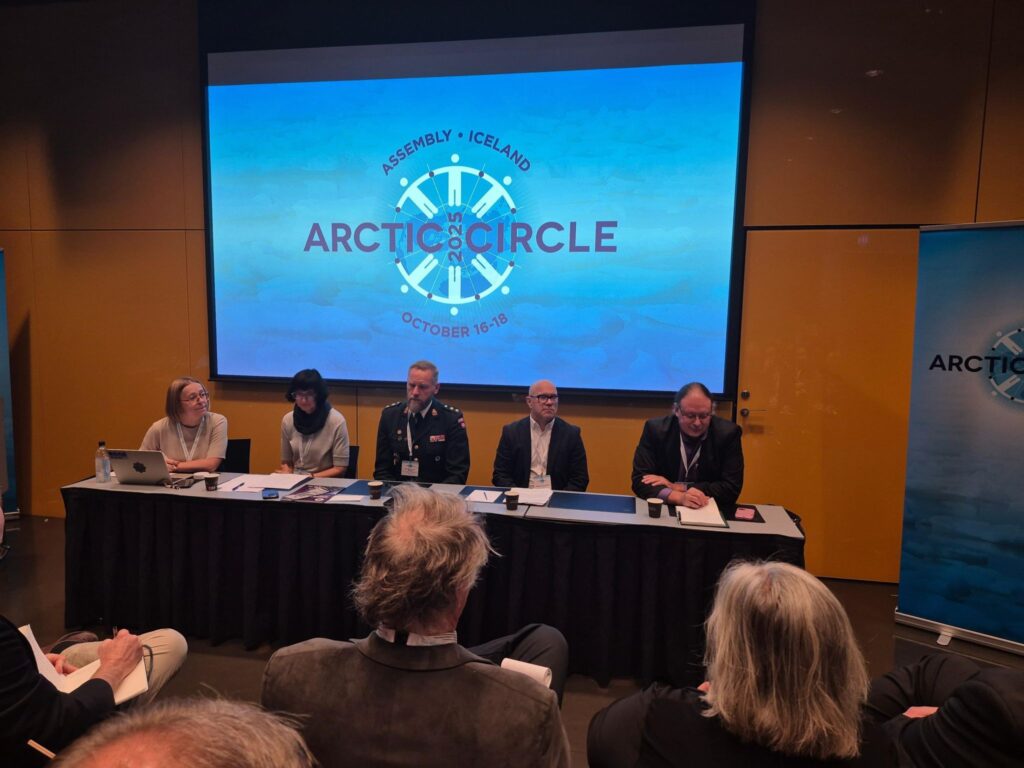Where science meets security: strengthening Arctic research cooperation
At the latest Arctic Circle Assembly in Reykjavik, ArcticNet convened a panel to examine how scientific and defence communities can strengthen research cooperation. This reflection builds on the insights shared during that session.
Joanna Hosa, ArcticNet Partnerships and Grants Manager, November 2025
Amidst accelerating climate change, geopolitical rivalries in the Arctic are intensifying. Arctic scientists, long used to operating in a peaceful zone of cooperation, now find themselves in an increasingly contested space. As security demands rise, defence institutions need a better understanding of the northern environment. In this context, cooperation between the military, Indigenous peoples, and scientific communities is becoming critical. In particular, what role should the scientific community play?
Such cooperation can bring both risks and opportunities. On one hand, researchers raise concerns about the securitization of Arctic research, academic freedom, FAIR principles in data management, data security, data ownership, , and ethical implications of participating in defence-related projects. On the other hand, close collaboration could pool resources, bring new funds, increase the use of scientific knowledge, and ultimately improve our common security in the North.
When we think about science and defence, public imagination tends to leap to dual-use sensitive technologies and highly classified research. However, in reality, many defence needs in the Arctic are far broader and do not need to be classified. For example, defence institutions will require improved data on underwater environments, under ice acoustics, permafrost dynamics, and the implications of climate change for military operations. They will also need more efficient energy solutions, expanded surveillance capability, and better sensing and data integration platforms. Much of this expertise already resides in academia and can be further developed there.
Canada’s Arctic security landscape also depends greatly on Indigenous Peoples, who are rights holders in much of the North, who are developing their self-government and whose communities and knowledge systems are central to resilience and sovereignty in the North and beyond. They contribute to environmental monitoring and situational awareness, search and rescue, protection of land and marine resources. Any cooperation between science and defence must include Indigenous leadership and uphold Indigenous data sovereignty.

Canada has long underestimated the importance of investment in defence and defence research, lagging behind many North Atlantic Treaty Organisation (NATO) partners. However, this is changing quickly. In June 2025, Prime Minister Mark Carney announced that Canada will meet NATO’s defence investment goal of 2% GDP this year, and joined the NATO Defence Investment Pledge of investing 5% of annual GDP by 2035 for security. Accordingly, the new Canada Strong Budget 2025 foresees significant resources for defence. While Defence Research and Development Canada (the science and technology arm of the Department of National Defence) has an impressive internal scientific capacity of roughly 500 scientists, the quick rise in defence spending means it will need far more external support to deliver on new priorities. This opens space for collaboration with civilian partners.
Other NATO countries have long had a broader understanding of defence cooperation than Canada. Norway, for instance, operates under the concept of “total defence,” whereby civilian and military cooperation is integrated, with sectors such as health, telecoms, research, transport or energy closely tied to defence planning. There is an emphasis on societal resilience and civilian preparedness. Other Nordic countries have a similar approach. In other words, defence is an all-of-society effort and research is recognized as central to national security and safety. Environmental and climate science directly informs situational awareness. A data-driven defence is ultimately a more reliable defence, and it fuels innovation across sectors. Working with defence is an opportunity for scientists to pursue research that otherwise struggles to find funding, but also a responsibility to contribute to a whole-of-society defence effort.
At the same time, researchers in the Arctic are already confronting geopolitical instability firsthand: the presence of unknown vessels near field sites or potential restrictions on where they can work. Some may find the encroachment of geopolitics into science unacceptable – but can we separate politics from research today? Could we ever?
Throughout its 20+ years of existence, ArcticNet researchers have worked with hundreds of partners, but not with defence. As the Arctic region grows more unstable and Canada steps up its defence investment, this may change. Preparing for that shift requires a clearer understanding of defence research needs, an honest assessment of what academia can support, and meaningful dialogue with Arctic Indigenous Peoples whose knowledge and governance responsibilities are central to northern security.
The challenge ahead is to shape science-defence cooperation in a way that strengthens security while respecting rights, safeguarding research integrity, and contributing to a stable Arctic for the communities who call it home. How can we achieve this? ArcticNet will continue this discussion, and if you would like to be involved, please contact Joanna at joanna.hosa@arcticnet.ulaval.ca.